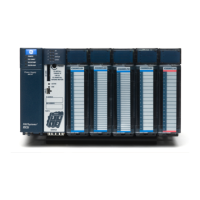Chapter 5. Function Block Diagram (FBD)
256 PACSystems* RX7i, RX3i and RSTi-EP CPU Programmer's Reference Manual GFK-2950C
MOV Operands
Calculated by the FBD editor.
data flow, I, Q, M, T,
G, S, SA, SB, SC,
discrete symbolic,
I/O variable
Bit reference in
a non-BOOL
variable
R, P, L, AI, AQ, W,
non-discrete
symbolic, I/O
variable
The source of the data to copy into the output
Q. This can be either a constant or a variable
whose reference address is the location of the
first source data item to move.
IN must have the same data type as the
variable in the Q parameter.
If IN is a BOOL variable or a bit reference, an
%I, %Q, %M, or %T reference address need not
be byte-aligned, but 16 bits beginning with the
reference address specified are displayed
online.
DINT, DWORD,
INT, REAL,
LREAL, UINT,
WORD, or bit
reference in a
non-BOOL
variable
All. S, SA, SB, SC
allowed only for
WORD, DWORD,
BOOL types.
The length of IN; the number of bits to move.
If IN is a constant and Q is BOOL:
1 LEN 16;
If IN is a constant and Q is not BOOL:
1 LEN 256.
All other cases: 1 LEN 32,767
LEN is also interpreted differently depending
on the data type of the Q location. For details,
see discussion under Move Data.
Indicates whether the operation was
successfully completed.
If ENO = ON (1), the operation was initiated.
Results of the operation are indicated in the FT
output.
If ENO = OFF (0), the operation was not
performed. If EN was ON, the FT output
indicates an error condition. If EN was OFF, FT
is not changed.
data flow, I, Q, M, T,
G, discrete symbolic,
I/O variable
Bit reference in
a non-BOOL
variable
I, Q, M, T, G, R, P, L, AI,
AQ, W, non-discrete
symbolic, I/O
variable
The location of the first destination data item.
Q must have the same data type as the
variable in the IN parameter.
If Q is a BOOL variable or a bit reference, an %I,
%Q, %M, or %T reference address does not
need to be byte-aligned, but 16 bits beginning
with the specified reference address are
displayed online.
DINT, DWORD,
INT, REAL,
LREAL, UINT,
WORD, or bit
reference in a
non-BOOL
variable
data flow, I, Q, M, T,
S, SA, SB, SC, G, R, P,
L, AI, AQ, W,
symbolic, I/O
variable

